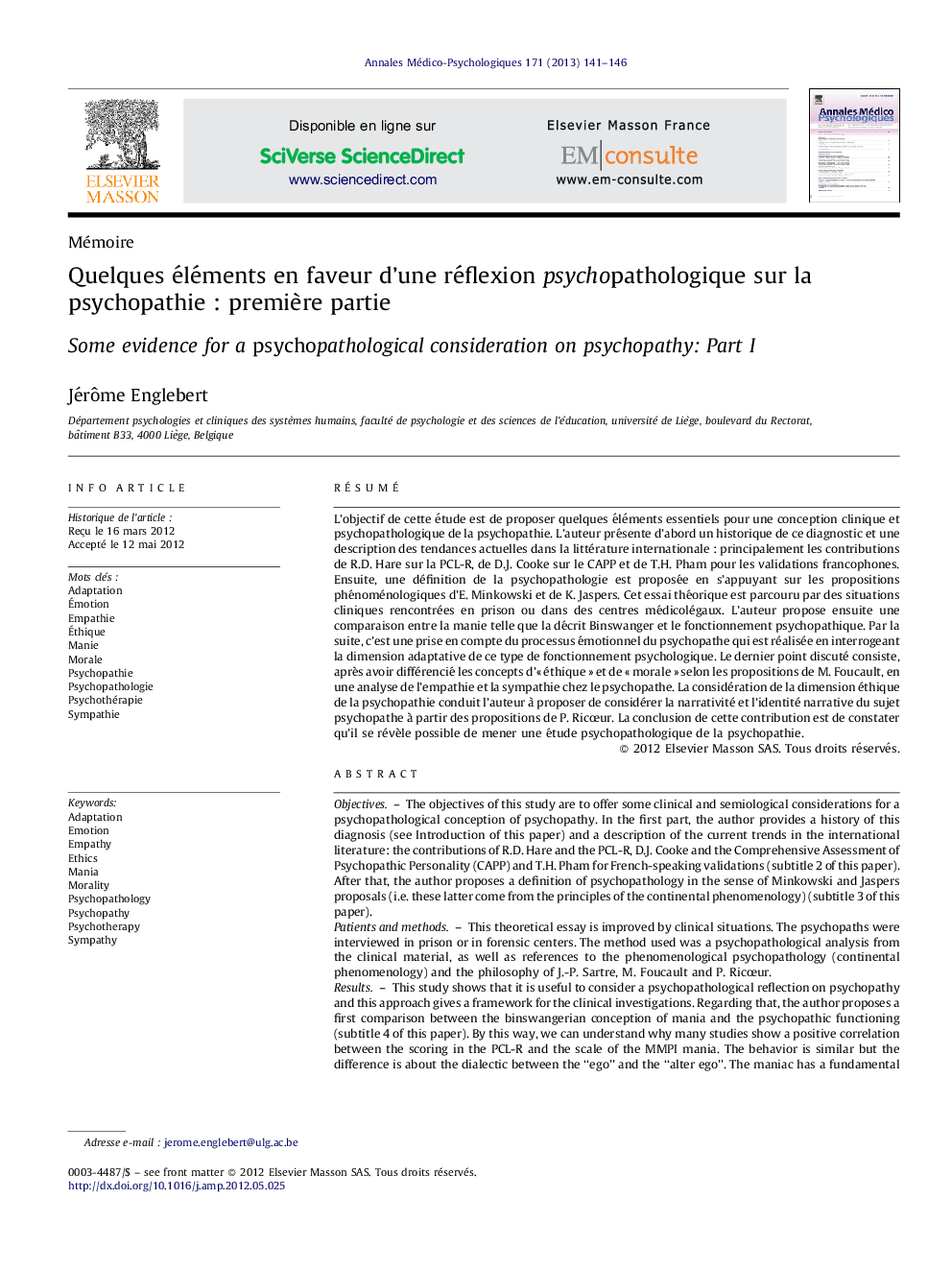| کد مقاله | کد نشریه | سال انتشار | مقاله انگلیسی | نسخه تمام متن |
|---|---|---|---|---|
| 313859 | 534546 | 2013 | 6 صفحه PDF | دانلود رایگان |

RésuméL’objectif de cette étude est de proposer quelques éléments essentiels pour une conception clinique et psychopathologique de la psychopathie. L’auteur présente d’abord un historique de ce diagnostic et une description des tendances actuelles dans la littérature internationale : principalement les contributions de R.D. Hare sur la PCL-R, de D.J. Cooke sur le CAPP et de T.H. Pham pour les validations francophones. Ensuite, une définition de la psychopathologie est proposée en s’appuyant sur les propositions phénoménologiques d’E. Minkowski et de K. Jaspers. Cet essai théorique est parcouru par des situations cliniques rencontrées en prison ou dans des centres médicolégaux. L’auteur propose ensuite une comparaison entre la manie telle que la décrit Binswanger et le fonctionnement psychopathique. Par la suite, c’est une prise en compte du processus émotionnel du psychopathe qui est réalisée en interrogeant la dimension adaptative de ce type de fonctionnement psychologique. Le dernier point discuté consiste, après avoir différencié les concepts d’« éthique » et de « morale » selon les propositions de M. Foucault, en une analyse de l’empathie et la sympathie chez le psychopathe. La considération de la dimension éthique de la psychopathie conduit l’auteur à proposer de considérer la narrativité et l’identité narrative du sujet psychopathe à partir des propositions de P. Ricœur. La conclusion de cette contribution est de constater qu’il se révèle possible de mener une étude psychopathologique de la psychopathie.
ObjectivesThe objectives of this study are to offer some clinical and semiological considerations for a psychopathological conception of psychopathy. In the first part, the author provides a history of this diagnosis (see Introduction of this paper) and a description of the current trends in the international literature: the contributions of R.D. Hare and the PCL-R, D.J. Cooke and the Comprehensive Assessment of Psychopathic Personality (CAPP) and T.H. Pham for French-speaking validations (subtitle 2 of this paper). After that, the author proposes a definition of psychopathology in the sense of Minkowski and Jaspers proposals (i.e. these latter come from the principles of the continental phenomenology) (subtitle 3 of this paper).Patients and methodsThis theoretical essay is improved by clinical situations. The psychopaths were interviewed in prison or in forensic centers. The method used was a psychopathological analysis from the clinical material, as well as references to the phenomenological psychopathology (continental phenomenology) and the philosophy of J.-P. Sartre, M. Foucault and P. Ricœur.ResultsThis study shows that it is useful to consider a psychopathological reflection on psychopathy and this approach gives a framework for the clinical investigations. Regarding that, the author proposes a first comparison between the binswangerian conception of mania and the psychopathic functioning (subtitle 4 of this paper). By this way, we can understand why many studies show a positive correlation between the scoring in the PCL-R and the scale of the MMPI mania. The behavior is similar but the difference is about the dialectic between the “ego” and the “alter ego”. The maniac has a fundamental crisis of the “ego”, which the psychopath does not have. A second finding of our investigations concerns emotions and the dimension of the adaptive psychopathic disorder (subtitle 5 of this paper). An epistemological discussion of the concept of emotions allows us to say that the psychopath is competent in the management of emotional stimuli, which confers a psychological advantage to him. In addition, fundamental research on the management of the emotional stimuli in the psychopath seems to confirm our hypothesis of an adaptive dimension for the psychopathic disorder. The last point we discuss is about “morality” and “ethics” for the psychopath (these notions are from the concepts of empathy and sympathy). On the basis of Foucault's distinction between these two concepts, it becomes possible to study these dimensions and integrate them in the practice of psychopathology. This proposal enables to introduce the concept of narrativity. This observation prompts the clinician to listen to the patient and to pay attention to how he has to tell himself.ConclusionsOur contribution shows that it is possible to conduct a study about the psychopathology of psychopathy. Our study is not intended to be complete and irrefutable. Our goal is rather to give some evidence for a psychopathological consideration on psychopathy (as indicated by the title of this paper). Finally, we offered some thoughts on the practice of psychotherapy by integrating the adaptive dimension of this disorder which, when it is missed, can lead to a psychotherapeutic stalemate.
Journal: Annales Médico-psychologiques, revue psychiatrique - Volume 171, Issue 3, April 2013, Pages 141–146